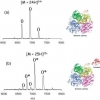Carla Bittencourt, Marcella P. Felicissimo, Jean-Jacques Pireaux and Laurent Houssiau
Laboratoire Interdisciplinaire de Spectroscopie Electronique (LISE), Facultés Universitaires Notre-Dame de la Paix, University of Namur, 61 rue de Bruxelles, B-5000 Namur, Belgium

